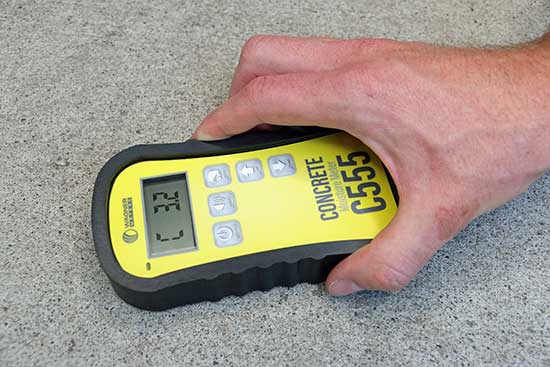Why You Need to Measure Moisture in Your Subfloor
You’re a pro. You measure the moisture in your wood flooring before installing it. And that’s because you understand how dangerous excess moisture is to flooring jobs.
But have you been measuring the subfloor for moisture, too? Whether it’s a wood or concrete subfloor, excess moisture could lurk below the surface—which would ultimately rise to the surface and come into contact with your wood floor. That means the beautiful wood floor you just laid could be in jeopardy.

A quick way to locate moisture “hot spots” in a concrete subfloor that you’ll want to test further is to use a handheld concrete moisture meter.
Yikes.
But no fear because this problem has an easy fix: test for moisture in your subfloor. And we’ll even tell you the exact tools you need to complete the job.
Why Should You Test Subfloors for Moisture?
You should test the moisture in your subfloors if you want your project to last. Bottom line.
Any unchecked moisture could lead to many issues: wood floor cupping, crowning, buckling, cracking, and in some cases, even mold or mildew.
To prevent all those costly disasters—and save you the headache of redoing the job—you must measure the moisture in the subfloor before any final preparations.
How Do You Check the Moisture Level in a Subfloor?
Depending on the type of subfloor you’ve got, there are different techniques.
Testing Concrete Subfloors
You can start by using a concrete moisture meter to locate the hot spots in the subfloor. But this is only a preliminary step. Next, use a relative humidity (RH) testing system to get quantitative data.
The best tools for the job are Wagner Meters’ C555, a concrete moisture meter, and the Rapid RH® L6 Testing System. And when they’re paired together, they’re an unbeatable duo to give you the best idea of the moisture in the subfloor. That way, you know when to install the flooring.
The C555 has a moisture reading range from 0-6.9%, and for best practices, you’ll want to install the Rapid RH sensors wherever it registers the highest moisture levels.
When you use the Rapid RH L6 Testing System, you know you’re following commonly used guidelines for relative humidity testing of concrete moisture. And nothing is better than having that peace of mind.
Testing Wood Subfloors
You’ll need an accurate and reliable wood moisture meter.
Luckily, we’ve got just the tool: the Orion® 950 from Wagner Meters. Along with all its other top-notch tech, the Orion 950 can measure as low as 5% moisture content.
But why is that so important?
What is the normal moisture reading for wood floors?
Your wood flooring should be in the 6-9% range before installation.
However, that depends on where you live. If, for example, you live in a more humid environment, such as a coastal area, these percentages might be higher.
But no matter where you live—at the beach, the desert, or anywhere in between—you’ll want to use an accurate and reliable moisture meter like the Orion 950.
Don’t Let Flooring Failures Cost You Time or Money
Especially because the preventative measures are easy enough.
Sure, they might be costly upfront. But it’s an investment in your success. After all, investing in high-quality moisture testing tools means you don’t have to dump more money into repair jobs.
With the whole moisture testing system from Wagner Meters—the C555, Rapid RH L6, and Orion 950—you’re ensuring you do the job right the first time.
To learn more about what Wagner Meters’ tools can do for you, visit wagnermeters.com or call (844) 574-0228 to speak to a representative.
Previously published in Tomorrow’s Contract Floors
Jason has 20+ years’ experience in sales and sales management in a spectrum of industries and has successfully launched a variety of products to the market, including the original Rapid RH® concrete moisture tests. He currently works with Wagner Meters as our Rapid RH® product sales manager.
Last updated on May 2nd, 2023



